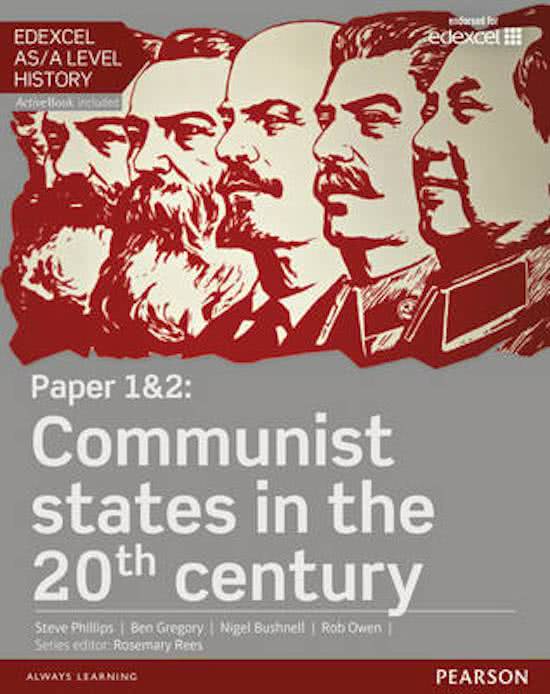Control of people, 1917-85 COMPLETE NOTES
How did the soviet government exercise control over the media, propaganda and religion
State control of the mass media and propaganda:
Newspapers
- Lenin moved quickly to stamp on any signs of freedom of the press, viewing
newspapers as mouthpieces to bourgeoisie
- A decree in November 1917 banned all non- socialist newspapers and by early
1920’s, all non Bolshevik papers were eliminated
o Printing press was nationalised
o All editors and journalists were employees of the government
o Approval from Glavit, the censorship office, was needed for every article that
was going to be published
- Daily newspapers included Pravda (truth) and Izvestiya(news)
o Pravda was the newspaper of the communist party and Izvestiya was the
paper of the government
o Both were used a vehicle of propaganda, highlighting achievements of the
government and socialism
o To ensure high readership, they were cheap and widely available
o Pravada had a circulation of 10.7 million in 1983 and Trud (labour) was more
popular with print run of 13.5 million
- Newspapers carried endless details about the achievements of socialism, with
production figures
o This fixation was particularly trie of the 1930s, under Stalin’s push to
industrialise
Favoured topics include successful expeditions to the Artic and
northern Russia
- Prohibited topics include plane crashes of natural disasters
o In July 1972, a vast fire got out of control outside Moscow, but the cities
population had to wait one month before the blue haze over the city was
explained
o A more serious disaster was in Kyshtym in September 1957, a nuclear storage
tank exploded, resulting in at least 200 fatalities and over 270,000 people
being exposed to dangerous radiations level, was ignored by the governments
press agency
The soviet public only became suspicious when map readers noticed
that 30 small communities disappeared from soviet maps between
1958 and 1991
Magazines
- A vast selection of magazines and journals were produced to cater for a range of interests
- Many of these were aimed at specific group of workers
o Some areas of interest were off limits such as sex, pornography, crime and religion
- Sovetski sport, was hugely popular magazine that gained respect for its accuracy and honesty
- Magazines had to carry political news and praising the government on its front page
, Radio
- In 1917, radio was a fairly recent development and therefore easier for the Bolsheviks to
influence
- Soviet scientists quickly developed voice radio and by 1921, programmes were being
broadcast
- Most radio programmes featured news and propaganda material
o Radio receivers were expensive and in order to get their message to the people, the
bolsheviks installed loudspeakers in public places such as factories and clubs
o Control of radio communications was centralised through the commissariat for Post
and Telegraphy
- Radio was especially useful in the earl days of the communist regime as 65% of the
population were illiterate
- The speed by which the government could convey messages through radio was invaluable
o Particularly during the invasion of the Germans in 1941, with Germans less than 50
miles from Moscow, Stalin gave a speech live
o It was to prove highly effective in reassuring the soviet population that not all was
lost in the war.
- Until 1964, there was only one Soviet radio system
o Under Brezhnev, the range was extended to three; one which placed some foreign
music and was popular with the Soviet Youth
- The government tried to restrict access to foreign stations by mass producing radios with
limited reception range
o They also had to rely on jamming foreign broadcasts and threatening to arrest those
how listened to voice of America or BBC
Television
- By 1950s, television was becoming a key method by which the government got its messages
to the Soviet public
- In 1950, the USSR had 10,000 sets; by 1958, this number had risen to almost 3 million
o By 1980s, most of the rural areas had access to television
- The government presented a number of documentaries (mostly of the achievements of
socialism)
o Life in the Soviet Union was presented as joyous whilst life under capitalism was
portrayed as rife with crime and homelessness
Results
- Censorship and restriction of material was heavily used, however, not always successful
- The soviet government got used to reading between the lines
o Eg news of the heart problems of a member of the politburo was interpreted as a fall
from favour
- The technology of mass media changed slowly from newspapers to televisions, but the
steady flow of propaganda contributed
- By the 1980s, technology was advancing further which acted both as a positive and a
negative for the communist party
o Video recorders made sharing of information much easier
o Computers however, were a much greater challenge to restrict information of the
outside world.
The personality cults of Stalin, Khrushchev and Brezhnev
Cult of personality: the adoration of an individual through the use of art and popular culture. It was
used as a method of enhancing the status of an individual leader and creating a sense of loyalty to
them





